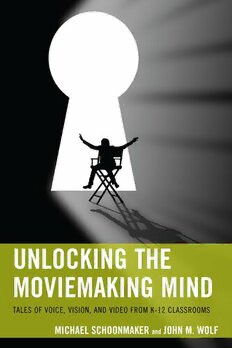
Unlocking the Moviemaking Mind: Tales of Voice, Vision, and Video from K-12 Classrooms PDF
Preview Unlocking the Moviemaking Mind: Tales of Voice, Vision, and Video from K-12 Classrooms
Unlocking the Moviemaking Mind Tales of Voice, Vision, and Video from K-12 Classrooms Michael Schoonmaker and John M. Wolf ROWMAN&LITTLEFIELDEDUCATION Adivisionof ROWMAN&LITTLEFIELD Lanham•Boulder•NewYork•Toronto•Plymouth,UK PublishedbyRowman&LittlefieldEducation AdivisionofRowman&Littlefield 4501ForbesBoulevard,Suite200,Lanham,Maryland20706 www.rowman.com 10ThornburyRoad,PlymouthPL67PP,UnitedKingdom Copyright©2014byMichaelSchoonmakerandJohnM.Wolf Allrightsreserved.Nopartofthisbookmaybereproducedinanyformorbyany electronicormechanicalmeans,includinginformationstorageandretrievalsystems, withoutwrittenpermissionfromthepublisher,exceptbyareviewerwhomayquote passagesinareview. BritishLibraryCataloguinginPublicationInformationAvailable LibraryofCongressCataloging-in-PublicationData LibraryofCongressCataloging-in-PublicationDataAvailable ISBN978-1-4758-0388-4(cloth:alk.paper)--ISBN978-1-4758-0389-1(pbk.:alk.paper)--ISBN 978-1-4758-0390-7(electronic) TMThepaperusedinthispublicationmeetstheminimumrequirementsofAmerican NationalStandardforInformationSciencesPermanenceofPaperforPrintedLibrary Materials,ANSI/NISOZ39.48-1992. PrintedintheUnitedStatesofAmerica Contents Preface v ByMichaelSchoonmaker Introduction:JourneytoVideoProductioninK-12 vii Section1:AddressingSocialJusticethroughSocialStudiesand Science xi TellingStoriesandStorytelling xiii 1 Instinct xv 2 Connection xxi 3 Nature xxv 4 Motivation xxix VideobeyondVocation xxxiii 5 Expression xxxv 6 Purpose xxxix 7 Solution xliii 8 Integration xlix DestinationandJourneyinVideoProduction liii 9 Reason lv 10 Invention lix 11 Resilience lxiii PartTwo:Locks lxvii BehindtheCamera,inFrontoftheLens:VideoandSelf- Discovery lxix 12 Boundaries lxxi 13 Acknowledgment lxxv 14 Paths lxxix VideoandVoice lxxxv 15 Listening lxxxvii 16 Hearing xciii 17 Perspective xcvii iii iv Contents 18 Noise ciii 19 Fringe cix 20 Humanity cxiii PartThree:UnlockingtheMoviemakingMind cxix MediaandLiteracy cxxi 21 Reciprocity cxxiii 22 Empowerment cxxvii 23 Transformation cxxxi TheMessIstheMessage cxxxvii 24 Motive cxxxix 25 Confabulation cxlv Conclusion clvii References clxi Preface By Michael Schoonmaker UnlockingtheMoviemakingMindisanunfoldingnarrativeaboutthegrow- ing potential of video production in K-12 classrooms. It is designed as a thought-provokingroadmapforteachersofallK-12subjectswhowantto findeffectiveandengagingwaystoinvigoratetheirtwenty-firstcentury lesson plans. It is written for teachers who have witnessed the natural fascinationkidshaveformediamakingandsharesinsightsfromarapid- lyexpandingpopulationofK-12teachersaroundthecountryandworld who have already tapped into the power of visual expression in their classrooms. Thebookexploresboththeknownandnot-so-knownfrontierofK-12. Videomaking is designed to equip teachers to meet their unique chal- lenges and objectives, in their own ways. Findings are derived from a widespectrumofactivitiesoverthepastfiveyears,including: • Updatestoandreconsiderationsofideasfrommybook Camerasin theClassroom (2007).InthisbookIconfrontedthestrangeanomaly that nearly all kids entering school are fully functional readers of visualmedia,yetK-12curriculawerestillhesitanttofullyembrace visual media in learning environments. On top of this, “visually- ready”studentsweretrappedinaholdingpatternintermsoftheir lackofaccesstothetoolsofvisualexpression.Theycan“read”the visualmediaofothers,buttheyareshortofthenecessarytoolsand skillsto“write”theirownvisualexpressions.Sincethen,therehas beenaslowbutsuremoveonteachers’partstocorrectthiseduca- tionalincongruity. • Test-flown perspectives first presented in my online column in SchoolVideoNews.ThecolumnwasdesignedtohelpK-12educators expand and improve the use of visual media in classrooms across thenation.TheteachersandstudentsIcametoknow throughthis experienceaddedexponentiallytomyknowledgebase. • Freshfindingsstraightfrommiddleschoolclassrooms:“TheSmart KidsVisualStoriesProject”—athree-yearstudyoftheroleofvisual media in giving voice to the voiceless: stories, insights, and ideas forreformfromstudentsinanurbanpublicschooldistrict. v vi Preface • Collaboration with my colleague John Wolf who has worked with meinmanyoftheaboveendeavorsandbringstothisbookadeep understanding of the convergence of humanity and technology, along with his true gift in finding order, however small it may be, inchaosofallshapesandsizes. And a final thought: Studying young moviemakers has certainly taught ushowkidscanusevisualexpressiontoenhancelearning.Butithasalso helpedusunderstandhowdeeplyentwinedhumanityandvisualexpres- sion are at the heart of any moviemaking experience, be it professional, educational, or recreational. There is a child within every moviemaker, andamoviemakerwithineverychild. Introduction: Journey to Video Production in K-12 Theundocumentedlifeisnotworthliving.Thissentiment—whetheryou agree with it, take issue with it, or just smirk at the Socratic reference— hyperbolicthoughitmaybe,isagoodreflectionofparticipatoryculture atthebeginningofthe21stcentury.Asinformationandcommunication technologieslikesmartphones,digitalvideocameras,anduser-generated contentsiteslikeYouTubecontinuetoevolveatarapidpace,we’repre- sentedwithfurtheropportunitiestodocumentourlives,shareourlived experiences,andactivelyparticipateindigitalstorytelling. Throughoutthisbookweexplorethepossibilitiesfordigitalstorytell- ing in the K-12 classroom. The findings are based on a multi-year re- searchprojectthatexaminedtheoutcomesandeffectsofdigitalstorytell- inginurban,publicschools.Narrativesfromtheseexperiencesareorga- nized thematically and presented in a three-part structure. Each part is composed of numerous chapters as well as interludes that serve to syn- thesizeandcontextualizeimportantinformation,ideas,andtheoriespre- sentedthroughoutthebook. Although this book tells a liner narrative from beginning to end, it isn’t necessary to read it linearly. Each part (described below) offers a uniquesetofusefulideasandstories,sofeelfreetoplanyourjourneyto suit your own needs or to jump around from one part of the book to another. WHYAREYOUHERE? Maybe you’re an educator who’s interested in somehow incorporating videoproductionintoyourlessonplans.Maybeyou’reanadministrator who wants to encourage her teachers to engage in classroom-based me- dia production exercises. Maybe you’re a graduate student who has an investmentinconstructionist,hands-oneducation.Maybeyou’reaschol- ar who’s surveying the current literature on the use of contemporary technologies in the classroom. Or maybe you just liked the cover of this bookandthoughtthetitlesoundedcool. Regardlessastowhyyou’rehere:Welcome.Thisbookiswrittenfrom thepointofviewoftwoeducatorswhohavespentyearsthinkingabout, writing about, and researching digital media production in the K-12 vii viii Introduction:JourneytoVideoProductioninK-12 classroom.Thisbookiswrittenforanyonewithaninterestinthissubject. Educatorswillfindusefulinformationandconvincingevidenceformak- ingtheleaptousingvideoproductionintheclassroom.Similarly,educa- tors who have already integrated video production into their curricula will discover useful philosophies as well as practical applications for re- fining their techniques. Students and scholars can indulge in findings from experimental research pertaining to storytelling, participatory cul- ture,andmediastudies.Andthosesimplywithaninterestinthesubject will discover a tale of untapped potential, unlikely hope, and creative ingenuity. The prospect of introducing video production in the K-12 classroom canseemdauntingatfirst.Youmayfindthatyourmindisoverwhelmed with questions at the very thought of it. What does it take to produce a video?WhatifIlackfamiliaritywiththenecessarytechnologies/vocabu- lary/skillsets? What makes a good video? What learning outcomes can video production help my students achieve? What if the school doesn’t havethebudget/funds/infrastructuretosupportsuchanendeavor?And countlessotherones,nodoubt. Whileitistruethatthereareagreatnumberofpractical,institutional, and systematic hurdles to overcome in introducing video production in theK-12classroom,thereisanequal,ifnotgreater,amountofsomething elsethatmakestheendeavorworththewager:Possibility.Inshort,video productionintheK-12classroomworks.Studentsengagedinvideopro- duction interventions display gains in self-esteem, self-efficacy, self-pos- session,andcriticalthinking.Studentswhoaremoreconfidentaremore likelytobelievetheycansuccessfullyundertakeassignedtasksand,thus, farebetterinschool. While we know from research and experience that video production interventionsworkinK-12classroomswhenexecutedproperly,wedon’t necessarily know why. Using data collected from several years of field- work,PartIexploreswhyvideoproductionseemstoworksowellinthe K-12 classroom. We begin by investigating storytelling as the core of video production and exploring the relationship between storytelling and the human condition. We then lay out some important considera- tionsforsuccessfullyimplementingdigitalvideoproductionintheclass- room. Finally, we present some tried and true methods and ideas for introducingstudentstovideoproductionasaneducationalresource. Part II presents evidence as to how digital video production can be usedintheK-12classroomtoovercomethoseindividualandsystematic challengesandbarrierscommontopubliceducation.Firstweinvestigate the relationships between video production, self-discovery, and motiva- tion.Nextweexplorevideoproductionasametaphorforvoiceandwhat it means for students to be able to articulate agency, to be heard rather thanmerelylistenedto,andtoknowinglysharemeaningfulpartsoftheir existenceswithothers.
